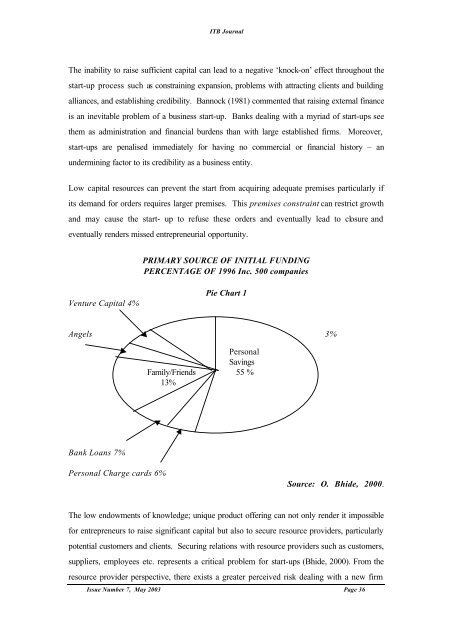ITB Journal-May-2003 - Institute of Technology Blanchardstown
ITB Journal-May-2003 - Institute of Technology Blanchardstown
ITB Journal-May-2003 - Institute of Technology Blanchardstown
Create successful ePaper yourself
Turn your PDF publications into a flip-book with our unique Google optimized e-Paper software.
<strong>ITB</strong> <strong>Journal</strong><br />
The inability to raise sufficient capital can lead to a negative ‘knock-on’ effect throughout the<br />
start-up process such as constraining expansion, problems with attracting clients and building<br />
alliances, and establishing credibility. Bannock (1981) commented that raising external finance<br />
is an inevitable problem <strong>of</strong> a business start-up. Banks dealing with a myriad <strong>of</strong> start-ups see<br />
them as administration and financial burdens than with large established firms. Moreover,<br />
start-ups are penalised immediately for having no commercial or financial history – an<br />
undermining factor to its credibility as a business entity.<br />
Low capital resources can prevent the start from acquiring adequate premises particularly if<br />
its demand for orders requires larger premises. This premises constraint can restrict growth<br />
and may cause the start- up to refuse these orders and eventually lead to closure and<br />
eventually renders missed entrepreneurial opportunity.<br />
PRIMARY SOURCE OF INITIAL FUNDING<br />
PERCENTAGE OF 1996 Inc. 500 companies<br />
Venture Capital 4%<br />
Pie Chart 1<br />
Angels 3%<br />
Personal<br />
Savings<br />
Family/Friends 55 %<br />
13%<br />
Bank Loans 7%<br />
Personal Charge cards 6%<br />
Source: O. Bhide, 2000.<br />
The low endowments <strong>of</strong> knowledge; unique product <strong>of</strong>fering can not only render it impossible<br />
for entrepreneurs to raise significant capital but also to secure resource providers, particularly<br />
potential customers and clients. Securing relations with resource providers such as customers,<br />
suppliers, employees etc. represents a critical problem for start-ups (Bhide, 2000). From the<br />
resource provider perspective, there exists a greater perceived risk dealing with a new firm<br />
Issue Number 7, <strong>May</strong> <strong>2003</strong> Page 36
















